My Perazzi High Tech – What’s so special about my gun of choice?
Sep 8, 2016 | Posted by David Radulovich
As many of you already know, Perazzi has recently released a new model,which I have started using, called the High Tech. I have had a lot ofquestions about the gun and what exactly the difference is between theHigh Tech and a regular MX8 or MX12. So, I’ve decided to write aShooting Journal entry about my new gun.
Now, when you see that somebody is doing an article on a new gun release, normally what the authordescribes are the different measurements in which the gun is offered,the length of barrels that you can get, and the different engravingsthat they offer — if you’re lucky, maybe you’ll hear about how muchrecoil the gun has (which is never really accurate), or how much smokeis produced when you actually hit a target.
All of these qualities aregreat to write about, but what nobody ever really touches upon in thesearticles is what truly separates each gun from their competition — whatmakes one gun better than another one?
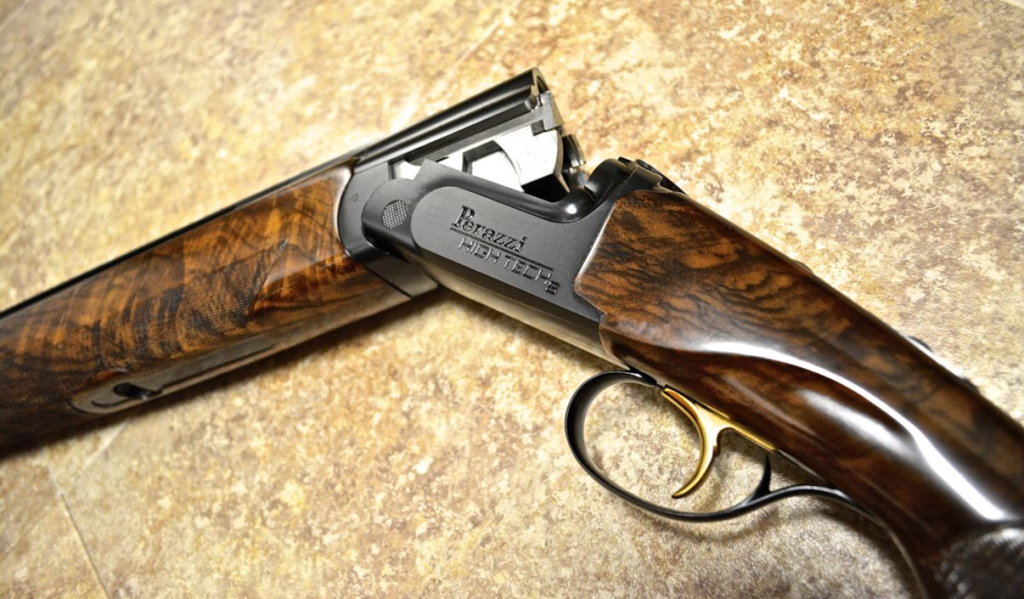
perazzi-high-tech2
If you’d believe most of these articles that you read, you’d probably come to the conclusion that there really is no difference between a gun priced at $3,000 or one at $12,000. This could not be further from the truth. Guns carry certain characteristics of movement based upon their overall design, the average person picking up a gun is not really going to feel a difference when they’re shooting because they haven’t attained a level of shooting where they would be able to — but if you put those same guns in the hands of someone who competes at a world level, they will immediately be able to tell the many differences between them. Now, just because you might not be able to “feel” these characteristics, it doesn’t mean that they aren’t there. Since this is the case, regardless of whether or not you know what to feel, it’s going to influence the way you shoot and score — dramatically.
At this point you’re probably asking yourself, “What in the world is Radulovich talking about?” — let me explain. This article is not going to be a “review” of the new Perazzi High Tech. What I want to do, is explain why the High Tech truly is the best gun available for competitive shooting, but I want to do so from a perspective that you never get to hear. I don’t want to talk about the materials used to make the gun (even though they are the best), or anything else along those lines. What I want to talk about is exactly why this gun allows me to shoot better than I would be able to with any other gun — from the perspective of my own shooting, as someone who competes at the highest level possible in the shooting sports.
For your convenience, and because this post is going to be fairly long with the included pictures, I have formatted each aspect of this article into the below sections. Each section is in an “accordion” so that whatever it is you would like to read, you can just click on it and it will appear. Descriptions of each section are in italics below each accordion:
There was a popular thread on ShotgunWorld recently about the guns used by some of the best professionals that influenced the release of this Journal Entry. Within that thread, in response to the details of my gun, someone asked the following question, “That is certainly an awesome looking gun! How do you like the feel of the High Tech over your past gun? I think you were shooting an MX2000S? Did it take a lot of getting used to? Have you shot any tournaments with the High Tech yet? If so, what were your results? I’m in the market for a new Perazzi, but I’m torn between going with a High Tech or staying with the more original design. Can you help?” The accordion above is my response.
Let’s get right into what the physical differences between my HTS (High Tech Sporting) and my MX2000/S (essentially a MX12) are. The standard bore diameter has been changed from 18.4mm to now 18.7mm — what does this do? It gives the shot more energy as it hits the target due to the fact that there is now less constriction when it is leaving the barrel, which also allows it to pattern better and reduces recoil further.
How about the action? Internally, it is exactly the same, so no differences there. Externally, the receiver has been widened to add 1.5oz of weight directly in-line with the point of impact on the first shot. What does this do? Well, because the weight has been added low and in-between the hands, it drastically reduces the recoil — honestly, by about 30% in comparison to my previous Perazzi. In addition to this, the added weight allows the gun to move more freely — I will touch on this in the “Movement Advantages” section.
The key characteristic of this additional weight is it’s location on the receiver. Why is the location of the added weight on the High Tech such an influence in the way that it handles recoil? Think of it this way, recoil has a direction — straight back from the chamber, which pushes the gun backwards in that direction. Because of physics, adding mass reduces the amount of “push” the gun has — but more importantly, the location of the mass influences the movement of the gun in response to that “push”. When extra weight is added high in the receiver and the gun discharges, the top half (location of the weight) is going to lag behind the bottom half in the “push” of recoil, because the bottom half is lighter. What does that do? It will feel as if the gun is “jumping” down at the barrels because the recoil is pushing the gun down. The reverse is also true. If the weight is below the chamber, the bottom half of the gun is going to lag behind the top half — giving the feeling of the gun “jumping” up into your face which equals more perceived recoil. In the Perazzi High Tech, the weight is added directly in line with the chamber, which absorbs the recoil in one direction and dampens your perception of it. This exponentially magnifies the influence of additional weight allowing for the 1.5oz increase to make a considerable reduction in recoil. Less recoil means less gun movement between shots.
I’ve included two photos so that you can see exactly where the weight has been added, notice the widened lower portion of the receiver:
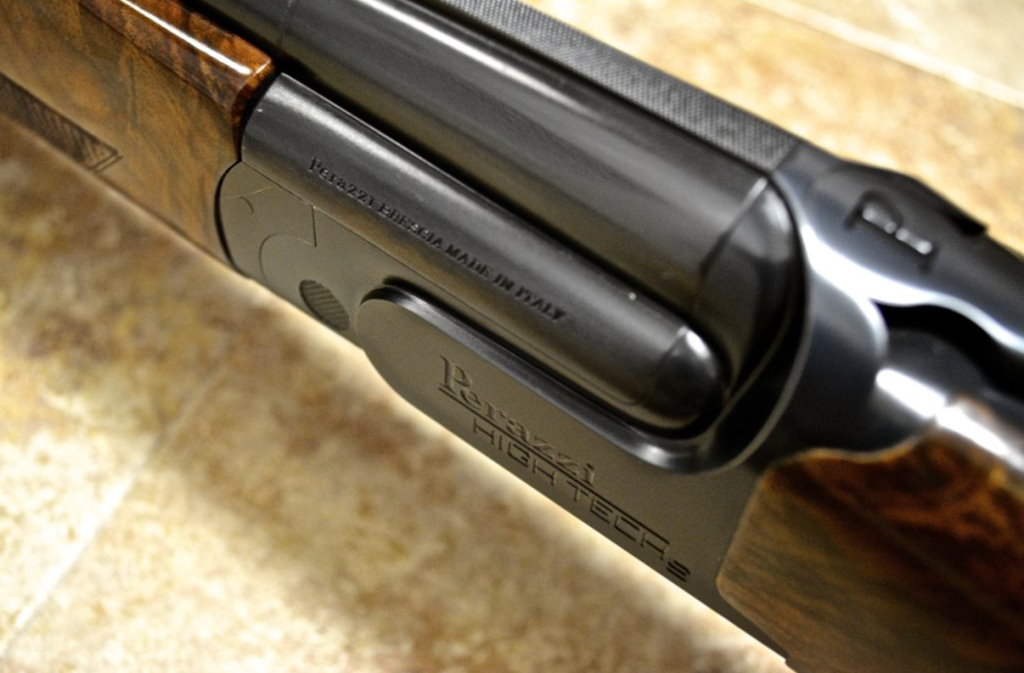
Perazzi HTS – Top View
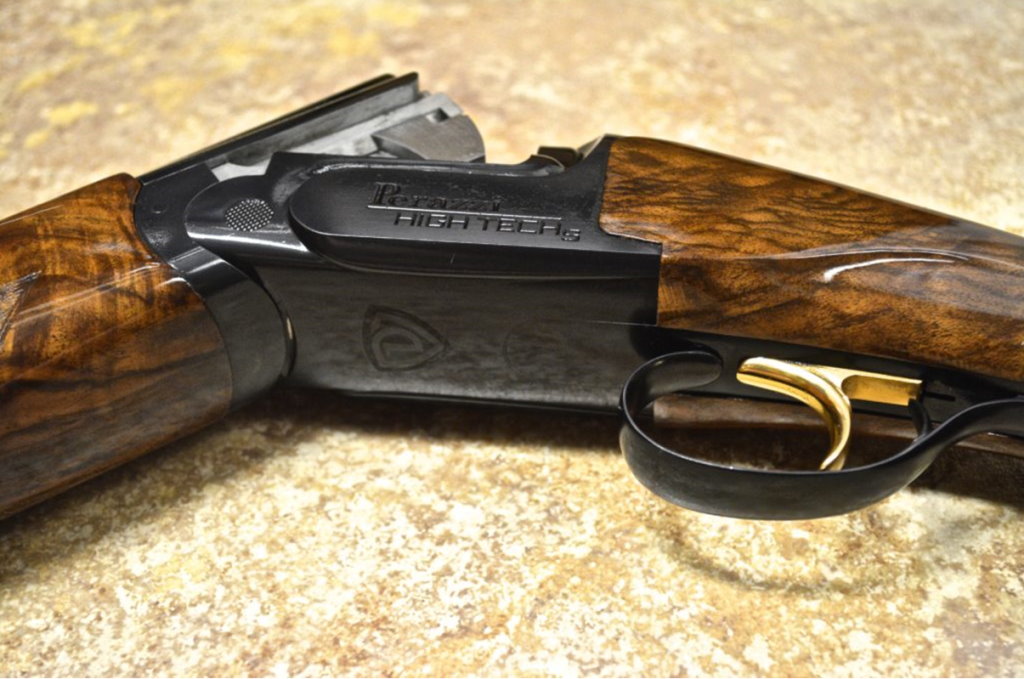
Perazzi HTS – Bottom View
The next thing to mention would be the obvious style choices for appearance, which I think compliment the gun very well. The stock and forend design has been slightly altered for visual effects only, except for one slight detail — the front end of the stock has been widened to compensate for the extra width of the receiver. (Please note, in the “Perazzi HTS – Bottom View” photo, my personal business logo is on the bottom of the receiver — this is a custom request by myself when ordering the gun and is not standard on all HTS models.)
Apart from it looking a little cleaner, it actually helps to absorb some of the recoil when the shot is discharged. If you haven’t noticed yet, this gun has almost zero movement when being fired, which is absolutely fantastic!
Here are three photos to demonstrate what I am talking about:
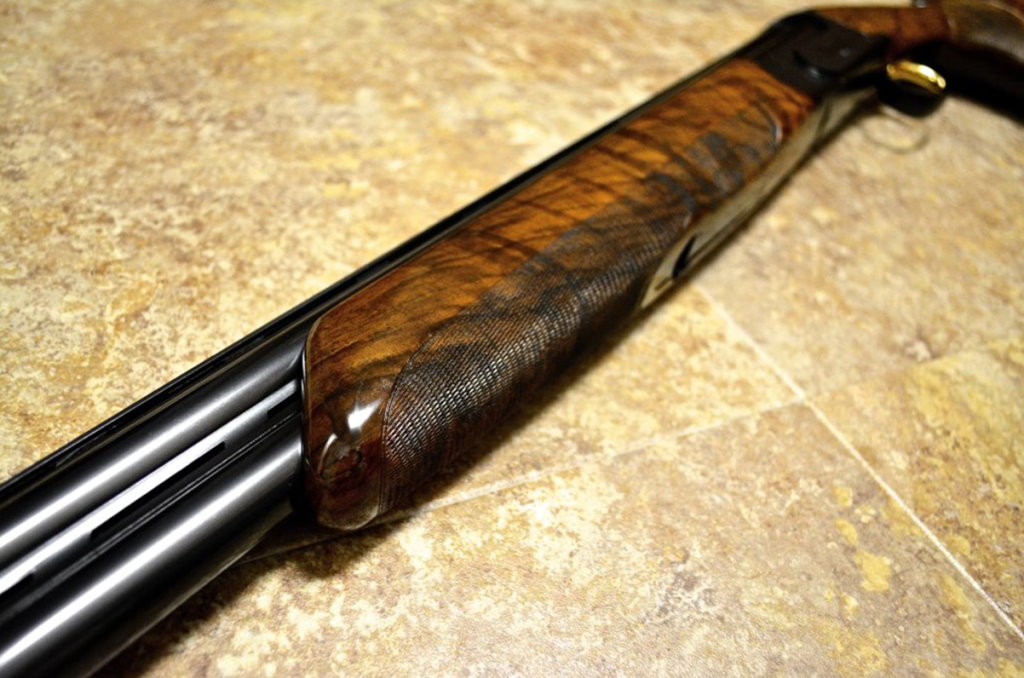
Perazzi HTS – Forend Angle
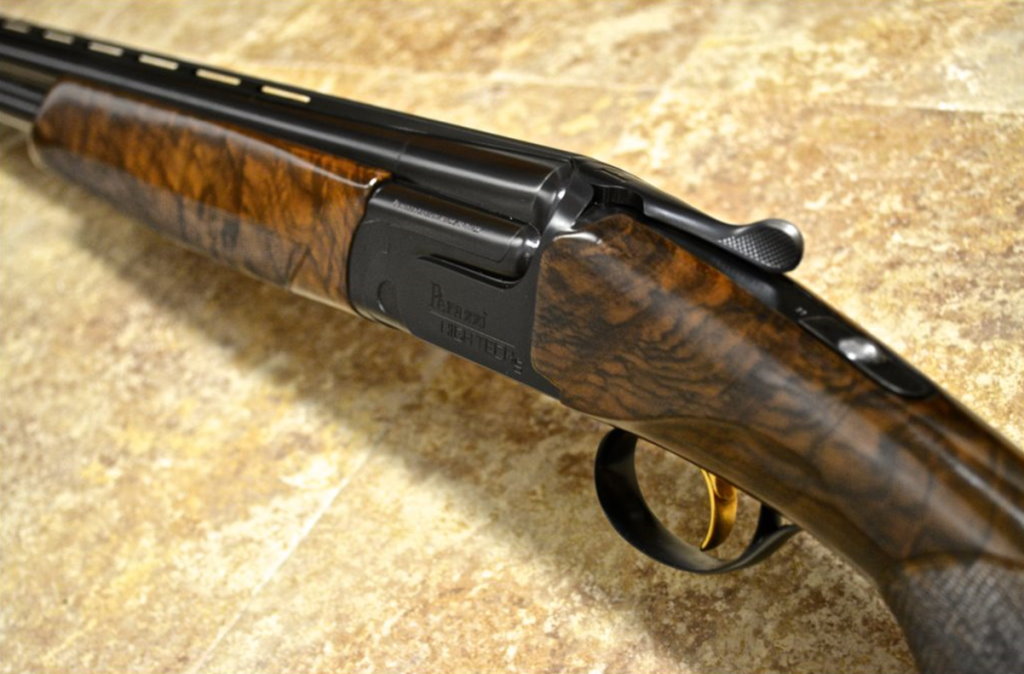
Perazzi HTS – Grip Width
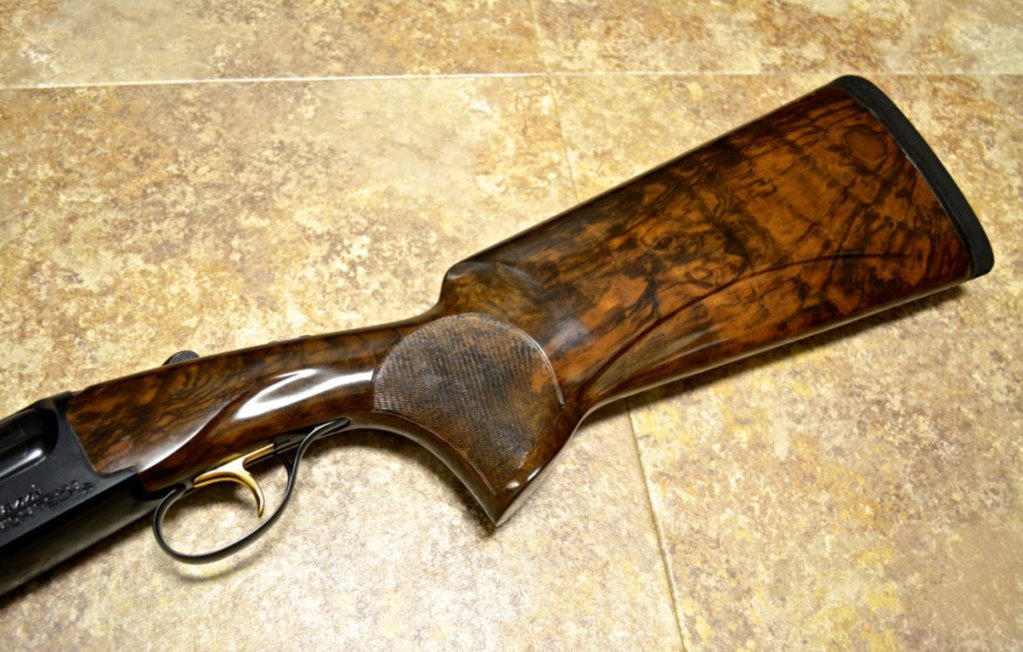
Perazzi HTS – Stock Stylization
In addition to the aforementioned differences between my HTS and MX2000/S, really the only other change is the width of the rib. On my previous gun, I had the standard flat 11x7mm competition rib — when ordering the HTS, I decided on choosing a flat 7x7mm rib. Why? For point-ability. I noticed that with my previous gun, the only difficult style of target for me was a long-distance incoming crow with zero movement at the breakpoint. I felt it was hard to point the gun accurately if I wasn’t moving, so I decided to go with a thinner rib to give my peripheral vision a more accurate pointing aid, and it worked.
I’ve included a picture to demonstrate what it looks like down the barrel of my gun:
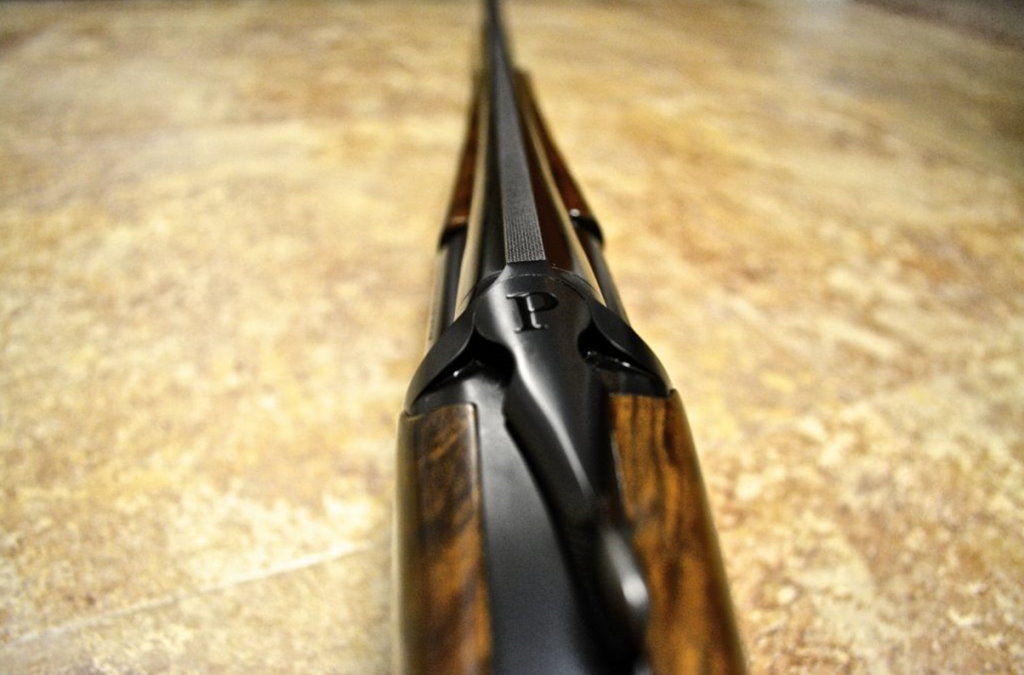
Perazzi HTS – 7x7mm Rib
You’ll notice that despite not being a tapered rib, because of the optical illusion, the 7×7 mm rib appears to taper at a visually appealing angle. I’ve found that this thinner characteristic allows me to frame a shot quicker than a traditional 11x7mm rib — meaning that it is visually more accurate and requires less time to place in the correct spot in-front of the target. It is important to note though, that I am never using my central vision to look down the rib of the gun while shooting — this is done solely with our peripheral vision and should never be consciously focused on during the shot.
In the above section, I talk about the physical and visual differences between my High Tech and the previous gun that I shot, the MX2000/S — I then go into details about how each change betters the design of the gun from the prospective of the shooter.
If you read the above section on the physical differences between the two styles of Perazzi’s, then you now understand the added width, weight, bore diameter, stylization, and recoil reduction. What you probably don’t know is how all of these things come together to create a beautifully moving piece of art in the form of a shotgun. It’s always been said that Perazzi is the Ferrari of shotguns — their attention to detail is unrivaled by any other shotgun manufacturer. Period. There is no arguing this, they make the best competition shotgun in the world. But why? Why is there a difference between a Perazzi, Beretta, Zoli, Kolar, Krieghoff, Blaser, etc.? It has to do with the actual design of the gun and the way that it carries momentum. Yes, you read that correctly. I’m not even going to go into build quality and overall lifetime durability, even though Perazzi is a forerunner in these categories, I want to stick to strictly how the gun influences shooting.
Every gun, unarguably, has a different look to it. A Krieghoff is much longer, more square, and less fluid. A Blaser is much more thin, smaller, lighter, etc. you get the point. What sets a Perazzi apart is the design of the action — the action is brilliantly simplistic but over-performs any other competitive shotgun design. The amazing part? The High Tech improved upon it. I’m going to try to explain why, in the most simplistic way possible.
In order to maximize the amount of targets that I hit during a round, I need to feel “connected” to as many targets as possible. I need to be able to produce a move with my gun that so closely mimics the movement of the target that I literally “feel” the target in my gun. There is no other way to describe it. Imagine shooting a gun that was big and clunky, a gun that carried it’s own momentum, a gun that in order to slow it down you literally had to “hit the brakes” on your connection to the target. If that’s the case, then the opposite would be true as well — in order to start a move to a target with that gun, you would literally have to give yourself time in the set-up (hold point) to be able to catch up to the target speed because the gun was so slow-to-start that you could get behind a target. This is what happens when you have an unbalanced and disproportionate gun. With a Perazzi, because of the action design, the gun literally moves effortlessly — wherever I take my eyes, the gun follows brilliantly. It’s a fantastic feeling and it only gets better with the new High Tech. Why? Because of the added weight between the hands. It smooths the gun out even more. When you drag out and lengthen the weight of a gun between your hands, it has the same influence over the movement of the gun when shooting — slow, drawn out, heavy. But when you make that weight distribution short and compact, it allows the piece to move with less effort and increased finesse.
Try this at home with your gun. Hold it in your hands down at your side like you were about to mount it, and pivot it in the center from side to side quickly. If you’re doing it right, and depending on your gun, you can feel where the gun creates most of it’s movement. If you’re shooting a Krieghoff, you’ll feel most of this movement coming from the back. If you’re shooting a Beretta, you’ll feel most of this movement coming from the front. Every gun is different. But only one gun will not allow you to locate that feeling of movement — the Perazzi. How does this translate to when you’re actually shooting? Simple, you have full control over how your gun moves with a Perazzi. Which means, you can be in perfect harmony with that target now. The advantage that this gives you is huge. Imagine shooting a quick pair of alternating quartering targets, where the second you shoot the first shot you are going to have to completely reverse the direction of your gun and connect to a target going the opposite direction. You’ll be wasting absolutely zero time doing it with my HTS because the balance of the design puts all the weight directly within your hands, and makes it compact enough that it doesn’t disproportionately drag out any extra movement.
Using that same demonstrative pair of targets, let’s imagine this…
You have to shoot that pair with a gun that carries momentum at the front (in the barrels): You’ll have a hard time connecting to the first shot quickly and easily because your gun is slow-to-start, which means you’ll have to open up your hold point in your set-up, which either moves your break point further out or shortens the amount of time you are going to be connected to the target — which makes for a more difficult first shot. After the first shot goes off, you now have to change directions completely with the gun, but your gun carries momentum, so you have to waste time slowing it down first. Once you get to your second hold point, you have to change directions again, more wasted time and movement. You will end up letting that target close it’s gap on your gun, forcing you to accelerate your speed, but because your gun carries momentum at the front, chances are you’re going to have a hard time not missing that target in front unless you are actively “hitting the brakes” throughout the whole second shot.
You have to shoot that pair with a gun that carries momentum at the back (towards your dominant hand): Right off the bat, the gun is very quick and easily over-maneuvered, so unless your hold point in your set-up is perfect, you’re going to blow way past the first target and have to slow down to let it catch you. This throws off your timing and makes a much more conscious shot. Your movement to the second target is going to be really fast and uncontrolled, but because your gun still carries momentum, it’s going to feel like you’re shooting a gun without barrels. This destroys any chance you have to finesse the gun and connect to the second target because it moves too quickly to control accurately — because of this, it forces your move to rely solely on timing, which means you have to be consciously focused on both the target and the barrel at the same time. That’s never good.
You have to shoot that pair with a gun that is balanced directly in-between your hands and compact (a Perazzi High-Tech): Your gun has zero momentum so if you aren’t absolutely perfect with your hold point in your set-up, you can get away with having to adjust during the shot. You are not going to have any issues maintaining the same speed of the target as you are connecting to it, because it doesn’t take any extra effort to speed the gun up or slow it down. Once you shoot the first target, changing directions happens as easily as moving your eyes from one spot to the other, the same is to be said about connecting to that second target and having to change directions a second time. If your timing is off coming in to the second target, no problem because you don’t have to waste any time speeding the gun up or slowing it down again — same as the first shot. The gun is going to naturally keep pace with the target if you keep your eyes focused on it.
Do you see how much more simplistic that whole process was? There’s a huge difference, and it’s all about minimizing the effort put into the shot so that you have exactly the amount needed to break both targets, but nothing extra to interfere with your move.
When I’m shooting, I want a gun that feels like it’s part of me. I don’t want to feel like I have this unbalanced, disconnected piece of steel and wood in my hands, and I’m trying to get it to point in the right direction. I don’t want to feel like I’m fighting the gun during the shot to get it where I want it to go. I want everything to happen naturally, I want everything to follow the movement of my eyes and body, and the only thing that’s going to be able to do that is something that is designed like a Perazzi.
In the above section, I talk about the advantages that the High Tech has over any other gun in respect to the way that it handles physically during the shot. Essentially, what the gun allows me to do that any other gun is incapable of doing in your hands, and how that translates to shooting higher scores with even less effort than before.
I’ve said this before, but I’ll say it again — I truly believe that a sporting gun should be as simplistically close to a natural extension of our hands and eyes as possible. You’ll notice that I have as flat and as straight of a gun as you can get. I don’t believe in using high ribs and tall stocks to separate the gun from our plane of sight, I don’t believe in crazy contorted stocks to improve comfortability of the gun, and I don’t believe in any type of forend design that changes the position of our front hand away from a natural pointing position. Why? Hand/Eye coordination. Imagine catching a baseball with a mitt that’s extended half a foot off of our hand — it’s a slight exaggeration from rib height, but you can understand that it would complicate the process. Shotgun shooting, in it’s most simple definition, is “pointing” a shotgun. When we remove the gun from the closest plane of our eyesight and throw something in-between the barrels and our eyes, all of a sudden we’ve complicated the pointing process. On top of this, we’ve changed the way that the gun feels and moves. At longer distance shots, what would you think would be more accurate to “point” — something smaller or something larger? It’s literally that simple.
The same goes for the stock, I want it to be as straight back as possible (as close to zero cast as you can get) — not only will this let your gun point better, but it drastically reduces recoil as well. Having a gun that is (what I like to call) crooked, directs the recoil of the shot off of the direction of the wood and makes the gun move more, which will make you feel more recoil in your face. I share the same philosophy with drop in the comb at the nose and heel of the stock.
In respect to the forend, I believe that it should be thin in order allow your hand to point out forward as straight as possible — this gives us the best control over the movement of the gun, and actually helps in the extension of hand/eye coordination when shooting. Having a thick forend doesn’t work very well for sporting; it allows you to move your gun fairly well vertically, but lacks the control for moving accurately in any lateral direction.
In the above section, I talk about how I believe a gun designed to shoot Sporting Clays should be set up, and why. I think it’s important to not only understand what is most efficient, but also understand why certain things work better than others. There is a lot of misinformation out there.
Model:
High Tech Sporting – Deep Black with Custom Logo
Balance:
5mm front of hinge pin
Lightened Monobloc
Barrel:
12ga
86cm length (34 inches)
1.650kg weight
0.28/0.28 fixed chokes (Light Full/Light Full)
7mm x 7mm flat rib
76mm chamber length (3 inches)
18.7mm bore diameter (0.736 inch)
Sideribs:
Half length (no sideribs under forend)
Ventilated (reduced weight and better control in wind)
Sight:
Game bead (smallest front sight)
Mid bead
Rib Checker:
Flat checkering
No tramline
Trigger Group:
Coil Springs
Selective (not that it matters — always shoot bottom barrel first)
*I do not specify trigger pull weight because I slap the trigger so I don’t notice
Stock Measurements:
Right handed
395mm length of pull (15.55 inches)
33mm drop at comb (1.3 inches)
43mm drop at heel (1.69 inches)
82mm grip length (3.23 inches)
Light palm swell
86.5 degree pitch
0mm cast at comb (0 inches)
0mm cast at heel (0 inches)
10mm cast at toe (0.39 inches)
*I like to keep the gun as straight and traditional as possible
Forend:
Thin english forend
290mm total length (11.4 inches)
*I like to have my front hand out as far as comfortable possible
Recoil Pad:
22mm Perazzi new style
In the above section, I talk about how I have my gun set up, and why. It is somewhat based off of the previous section; but in here, I go more in depth into how I designed my gun and the specific purpose of each characteristic that I have selected.
The greatest thing about purchasing a Perazzi is the level of customizability that you can get for no additional cost than just picking one up off of a rack in a store. You can truly make your gun fit you so that the gun moves and works effortlessly with your style of shooting — no other gun has the ability to do this anywhere close to the price point of a Perazzi.
Having an experienced professional competitor like myself help you with your order brings with it an unrivaled benefit, in that you will have somebody there that not only knows the physical characteristics of the different options available on your gun, but also how each subtle change will influence your shooting — how it will make the gun “feel” when you shoot it. Since every different type of Perazzi build has it’s own unique strengths, it makes sense to build one bespoke to you so that you can take advantage of all of them. That is something that only the highest level of competitor has experience with understanding.
With friendly permission of David Radulovic

